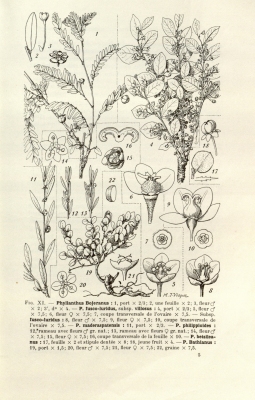Phyllanthus bojerianus
(Baill.) Müll.Arg.
Phyllanthaceae
Diasperus bojerianus (Baill.) Kuntze
Kirganelia bojeriana Baill.
Phyllanthus atroviridis Müll.Arg.
Common Name:
General Information
Phyllanthus bojerianus is a slender shrub, sometimes with a climbing habit, and growing around 1.5 metres tall[
299- Title
- Protabase - Plant Resources of Tropical Africa.
- Publication
-
- Author
-
- Website
- http://www.prota.org
- Publisher
-
- Year
- 0
- ISBN
-
- Description
- An excellent on-line database with detailed information on over 3,200 species of useful plants of Africa.
].
The plant is harvested from the wild for local use as a dye.
Known Hazards
None known
Botanical References
455- Title
- Flore de Madagascar et des Comores
- Publication
-
- Author
- Humbert H.
- Website
- http://www.biodiversitylibrary.org/
- Publisher
- Museum National D'Histoire Naturelle; Paris
- Year
- 1946 - 1984
- ISBN
-
- Description
- Written in French, an excellent flora of the area though it has not been completed. Available for download from the Internet.
Range
Africa - Madagascar.
Habitat
Rocky localities at elevations up to 1,600 metres[
299- Title
- Protabase - Plant Resources of Tropical Africa.
- Publication
-
- Author
-
- Website
- http://www.prota.org
- Publisher
-
- Year
- 0
- ISBN
-
- Description
- An excellent on-line database with detailed information on over 3,200 species of useful plants of Africa.
].
Properties
| Other Uses Rating |   |
| Habit | Shrub |
| Height | 1.50 m |
| Self-fertile | No |
| Cultivation Status | Wild |
Cultivation Details
A dioecious species, both male and female forms need to be grown if fruit and seed are required[
299- Title
- Protabase - Plant Resources of Tropical Africa.
- Publication
-
- Author
-
- Website
- http://www.prota.org
- Publisher
-
- Year
- 0
- ISBN
-
- Description
- An excellent on-line database with detailed information on over 3,200 species of useful plants of Africa.
].
Edible Uses
None known
Medicinal
Although the chemical composition of Phyllanthus bojerianus has not been investigated, the reaction of the plant with black ferruginous mud tends to indicate that this species, like several other Phyllanthus spp., is quite rich in tannins[
299- Title
- Protabase - Plant Resources of Tropical Africa.
- Publication
-
- Author
-
- Website
- http://www.prota.org
- Publisher
-
- Year
- 0
- ISBN
-
- Description
- An excellent on-line database with detailed information on over 3,200 species of useful plants of Africa.
].
Other Uses
The leaves or shoots are used to colour fibres blackish, often with alum as a mordant[
299- Title
- Protabase - Plant Resources of Tropical Africa.
- Publication
-
- Author
-
- Website
- http://www.prota.org
- Publisher
-
- Year
- 0
- ISBN
-
- Description
- An excellent on-line database with detailed information on over 3,200 species of useful plants of Africa.
].
They are first bruised and then the mixture is boiled. When the decoction has become deep red, black mud is added, together with the fibres to be dyed. The mixture is regularly stirred and the fibres rubbed for a period of 12 hours. When the fibres have become black, they are dried[
299- Title
- Protabase - Plant Resources of Tropical Africa.
- Publication
-
- Author
-
- Website
- http://www.prota.org
- Publisher
-
- Year
- 0
- ISBN
-
- Description
- An excellent on-line database with detailed information on over 3,200 species of useful plants of Africa.
].
Another method is to boil a mixture of bruised leaves with those of Syzygium jambos. The fibres are first covered with black mud and added to the boiled mixture, in which they are left for 2 days. The fibres are then taken out, washed and dried[
299- Title
- Protabase - Plant Resources of Tropical Africa.
- Publication
-
- Author
-
- Website
- http://www.prota.org
- Publisher
-
- Year
- 0
- ISBN
-
- Description
- An excellent on-line database with detailed information on over 3,200 species of useful plants of Africa.
].
Propagation
Seed -
If you have any useful information about this plant, please leave a comment. Comments have to be approved before they are shown here.


 Useful Tropical Plants Database 2014 by
Ken Fern,
web interface by
Ajna Fern
with help from
Richard Morris.
Useful Tropical Plants Database 2014 by
Ken Fern,
web interface by
Ajna Fern
with help from
Richard Morris.